Knee valgus is a very common occurrence in the weight room. It’s also common in sports. Hell, you can even go to a public place and examine people’s walking form and detect knee valgus in a minority of individuals. In this blogpost, I am going to teach you all about knee valgus and how to go about correcting it.
What is Knee Valgus?
Knee valgus is also referred to as valgus collapse and medial knee displacement. It is characterized by hip adduction and hip internal rotation, usually when in a hips-flexed position (the knee actually abducts and externally rotates). It can also be thought of as knee caving as you sink down into a squat or landing. When standing on one limb, the opposite side pelvis will usually drop during valgus collapse as well.
Why is Knee Valgus Dangerous?
Knee valgus can lead to patellofemoral (knee) pain, ACL tears, and iliotibial band syndrome. It can also lead to ugly squat syndrome.
When Does Knee Valgus Typically Occur?
Knee valgus most commonly occurs during upright ground-based activities that require eccentric action of the hip extensors. Essentially, gravity acting on the body induces large adduction and internal rotation torques on the hips while the hips move into flexion. The hips must absorb and reverse the sagittal plane flexion torque while stabilizing the femur in the frontal and transverse planes so the knees track over the toes. For many individuals, this is easier said than done.
You’ll commonly see valgus collapse rearing its ugly head during squatting, lunging, jumping, landing, climbing and descending stairs, and even during gait/running.
While you won’t see many instances of knee valgus during hip-hinging motions such as conventional deadlifts or good mornings, it does occur on occasion. I’ve actually trained a few clients that were so weak and deconditioned that their knees caved inward when performing a body-weight Romanian deadlift (simple hip hinge task with no load). This is rare, and it typically occurs with individuals who experienced a lower body injury and never rehabilitated it properly. You won’t see knee valgus occur very often during hip thrusts either, but if you do it’s much more easily correctable compared to knee valgus during squatting due to the lesser adduction/internal rotation torques and lesser hip flexion ROM.
Are Women More Prone to Exhibiting Knee Valgus?
Yes. Women are more prone to experiencing knee valgus due to their proportionately wider hips, increased Q-angles, diminished hip strength, and in my opinion from being taught to “sit like a lady” (along with reinforcing that movement pattern repeatedly throughout their lives).
Why Does Knee Valgus Occur?
As to what’s causing the valgus collapse, in the research it has been suggested that knee valgus can be caused by four primary fixable factors. I’ve arrange them in order of most likely to least likely, based on my informed opinion:
1. Weak Hips
Inadequate gluteal/hip strength (gluteus minimus, glute medius, gluteus maximus, hip external rotators), possibly in conjunction with overactive hip adductors, prevents proper stabilization of the femur. The hips then move into adduction and internal rotation. And when the adductors are overactive in comparison to the glutes/hip external rotators, the knee is similarly pulled into valgus collapse.
2. Tight Ankles
Inadequate ankle dorsiflexion mobility along with tight lower leg musculature (gastrocnemius, soleus, and anterior tibialis) prevents the tibia/knee from migrating forward sufficiently. This causes the foot to compensate by pronating (allowing for more forward knee migration), forcing the tibia to internally rotate, which leads to hip internal rotation and hip adduction, and therefore knee valgus.
3. Impaired Quad Function
Inadequate VMO (vastus medialis obliquus) strength will fail to allow for proper knee stabilization, which will cause the knee to track inward.
4. Impaired Hamstring Function
Inadequate medial hamstrings (semimembranosus and semitendinosus) strength will prevent proper stabilization of the knee which will lead to some medial knee displacement, similar to what happens with impaired VMO function but on the opposite side of the thigh.
Knee valgus could initiate from a combination of these factors, but once it “sets-in,” it becomes a brain/nerve problem and not just a strength or flexibility problem. Therefore you’ll always have to re-groove squat patterns even when restoring impairments or imbalances.
Are There Any Other Reasons that Could Influence the Knees to Cave When Lifting?
Yes. It’s been suggested in the research that knee valgus could occur for purposes of mechanical advantage. Specifically the gluteus medius loses all of its leverage (called a “moment arm” in sports science) as a hip abductor at the bottom of a squat. However, if the hip is internally rotated, the gluteus medius regains some of its leverage as a hip abductor. However, this same hip internal rotation at the bottom of a squat would cause the gluteus maximus to lose some of its leverage as a hip extensor, so it would be a slight trade-off. When maxing out or repping to failure, the body will take the path of least resistance, so this might explain the tendency to want to cave in at the knees. However, this is yet to be thoroughly examined in the literature.
Anatomy also plays a considerable role in contributing to knee valgus. Pelvic width, acetabulum shape, femur shape, knee shape, tibia shape, ankle shape, foot shape, ligament laxity, along with tendon attachment points for hip and lower body muscles, can all influence the likelihood of knee valgus occurrence. Some individuals are much more prone to exhibiting valgus collapse than others based on their anatomy.
Is Knee Valgus Occurrence Always Due to Deficits in Mobility or Stability?
As mentioned above, knee valgus is often due to insufficient hip strength or inadequate ankle mobility. However, knee valgus can also be due to faulty motor patterning. Many lifters simply learned to squat that way and just don’t know any better as they’ve never been taught proper form. They might have all the stability and mobility needed to squat properly, but they just require proper coaching and practice.
What’s the First Step in Correcting Knee Valgus?
First, you must determine if the issue is due to deficits in:
- Ankle Dorsiflexion Mobility,
- Hip Stability, or
- Coordination
How do I Know if the Knee Valgus is Due to Insufficient Ankle Dorsiflexion ROM?
Test the box squat to parallel depth (or slightly lower) and examine ankle dorsiflexion mobility in a half-kneeling position.
If box squats are performed properly (with no knee valgus), but the knee moves into valgus when performing full squats, then this is a good clue that knee valgus is occurring due to ankle dorsiflexion deficits. Moreover, if the foot heavily pronates during the full squat, this is another good clue that inadquate dorsiflexion mobility is the culprit.
You can also test ankle dorsiflexion ROM from a half-kneeling position to determine how much functional ankle dorsiflexion ROM an individual possesses. I prefer testing weight-bearing positions rather than non weight-bearing positions as 1) individuals have much more ROM during weight-bearing, and 2) weight-bearing is characteristic of the squat and other functional positions, so it’s more specific to what you’re trying to improve.
In the video below, you’ll see the individual performing an ankle mobility drill with a dowel. Placing the dowel on the outside of the foot and ensuring that the knee still tracks outside of the foot is ideal as this prevents foot pronation so you get a good estimation of one’s true ankle dorsiflexion ROM.
Make sure the heel stays flat and the foot doesn’t pronate. To determine your functional ankle dorsiflexion ROM, perform the drill above and pause at end-range. Take a snap-shot from the side view or measure with a goniometer to determine the angle. Perform this barefoot.
How Much Ankle Dorsiflexion ROM is Normal, and What’s Needed in a Squat?
This depends on the anthropometry of the lifter and the type of squat being performed. It also depends on the shoe being worn. Olympic weightlifting shoes have high heels on them, and this greatly increases the potential for the knee to migrate forward and the tibia to form a more acute angle relative to the ground. For testing purposes, I recommend being barefoot.
Normal ankle dorsiflexion ROM under weightbearing is 7-35 degrees, according to THIS study. Different types of squats and body types require varying levels of ankle dorsiflexion. A full squat requires considerable ankle dorsiflexion. A full squat with an upright torso requires even more (sometimes over 45 degrees). Alternatively, a high box squat doesn’t require any ankle dorsiflexion (0 degrees), especially when you sit back properly. In fact, in THIS article, Louie Simmons mentions that you can sit back so far in a box squat that you surpass a vertical tibia, which would create slight plantarflexion.

Sure she’s wearing Olympic shoes, but this is still some serious ankle dorsiflexion – around 45 degrees. Still, it’s not enough for this upright of a squat. Notice the foot pronation and subsequent internal rotation of the tibia and hip.

However, only around 10 degrees of ankle dorsiflexion is required for the same lifter with this type of squat.
If a lifter lacks the required ankle dorsiflexion ROM to perform a particular style of squat, in order to reach depth they will either:
- Round their spine,
- Rise up onto the balls of their feet, or
- Pronate their feet (which leads to knee valgus).
For these lifters, corrective ankle dorsiflexion mobility drills and calf stretches are imperative. I’ll teach you some great drills and stretches for this purpose later in this article.
How Does Foot Pronation Help Achieve Greater Forward Knee Migration?
Think of the toe-touch or the sit-and-reach test. You think you’re testing hamstring flexibility, but really you’re getting a combination of spinal, pelvis, and hip range of motion. If you want true hamstring flexibility, then neutral spine and pelvic postures must be employed, which dramatically reduces the total ROM.
In the same manner, you get more ROM when the ankle dorsiflexes and the foot pronates compared to ankle dorsiflexion alone. Here is a picture of my ankle dorsiflexion ROM compared to my combined ankle dorsiflexion and foot pronation ROM. Notice I get around 10-15 degrees more ROM with the foot pronated.
This is why many lifters pronate – to get more ROM to allow for greater squat depths. This is not ideal though and it’s akin to allowing for spinal flexion to compensate for insufficient hip flexion mobility/hamstring flexibility in a deadlift. Sure it’ll get the job done, but it the process it can wreak havoc on the body.
How do I Know if the Knee Valgus is Due to Insufficient Hip Stability?
Either have a partner/coach create “artificial hip stability” by forcing the knees out for the lifter while the lifter descends in the squat, or squat in front of a pole and hold onto it for stability. If proper squat position can be reached, with proper foot supination, proper ankle dorsiflexion, proper knee tracking, and a realistic torso angle that’s similar to real squatting, then this is a big clue that the issue is related to inadequate hip stability.
If good squat position can be reached with a little assistance, then the lifter just needs to bring his/her hip stability up to par. I will discuss the best corrective exercises for this purpose later in the article.
How do I Know if the Knee Valgus is Due to Lack of Coordination?
This one is simple. If the issue is a matter of coordination and lack of knowledge of technical form, then within approximately five minutes of coaching and practice, the lifter will be able to perform a proper bodyweight squat with proper knee tracking (no knee valgus). Surprisingly, this works on a fair amount of beginners – they just need to learn what good squat form is supposed to look and feel like.
If I Bring an Individual’s Hip Strength or Ankle Mobility Up to Speed, Does This Automatically Fix Their Knee Valgus?
No, it doesn’t. Studies show that strength training alone can indeed improve knee valgus, as can motor re-education. However, you need both strength and technique work for maximum results in the quickest amount of time. Neither strategy alone will achieve this – both are needed.
Case in point – you can usually strengthen the heck out of a lifter’s glutes with hip thrusts and band walking exercises, or you can stretch/mobilize someone’s calves/ankles repeatedly over a couple of months, yet this does not automatically fix their valgus collapse when squatting.
At the end of the day, if you want to correct knee valgus, even after you’ve restored ankle mobility and/or hip stability deficits, you have to lighten up the load and re-learn how to squat with the knees tracking over the toes.
In fact, you can even squat with the knees slightly outside of the toes which is called knee varus – the opposite of valgus. Click on the link to Simple Squat Correction for a video and blogpost on the concept of slight knee varus during the squat.
How Long Does it Take to Fix Knee Valgus?
I’ve had clients clean up their form within 5 minutes and others who took 3 months to correct when using heavy loads, depending on the circumstances. However, one quality session doesn’t insure that solid performance is “locked-in.”
Motor re-programming takes time and requires persistence. It has been suggested that a motor engram (memorized movement pattern) requires thousands of repetitions of proper performance to become ingrained. Obviously there are some who learn more quickly than others due to increased kinaesthetic awareness, but hopefully you catch the drift as to how much work is required for automaticity to be reached.
Lifters need to get to a point where they don’t have to think “knees out,” it just happens automatically.

You might be strong at squatting with your legs aimed forward, but you need to get strong and accustomed to squatting with the legs angled outward.
So it’s Mostly Beginners who Fall Prey to Knee Valgus?
Not always. The majority of newbies do indeed exhibit knee valgus when they squat. But often experienced lifters can squat just fine until reps are pushed to failure or loads approach 1RM. When pushing it to the limit, they often cave inward a bit at the knees. This means that their bodies can control knee tracking just fine unless the system is pushed to the limit.
In fact, many Olympic weightlifters, powerlifters, and strongmen exhibit knee valgus when squatting heavy – are you going to tell them that they all have weak glutes?
Many Olympic lifters exhibit what I call a “Valgus Twitch” when they squat. They initiate the concentric portion of the squat with the knees out, and then at the sticky region the knees migrate inward, and finally they travel back outward after the passing of the sticky region. See the video below for some examples.
What are Energy Leaks and Why Should I Care?
Energy leaks are eccentric contractions due to the neuromuscular system’s inability to maintain a static hold. Are all cases of energy leaks the same? Not really. There’s a difference between a newbie collapsing at the knees because he/she has dysfunctional ankles or hips and a 500 pound squatter allowing for some controlled medial knee displacement. The 500 pound squatter could easily keep his knees tracking perfectly over the toes when using 400 pounds (80% of his 1RM), but when maxing out he will allow for some wiggle room.
For safety purposes, you want to limit the energy leaks to strategic periods of time (competitions or testing your max). Most of the time in training, you want to use strict form. By preventing knee valgus, you’ll ensure that the load on the knees are distributed evenly so that the lateral aspects of the knee joint is protected. This will allow you to train pain and injury free so that you can continue to build up your strength indefinitely.
Is Technique Work and Motor Re-Education Your Best Bet for Correcting Knee Valgus?
Yes, but not always. As I mentioned earlier, if knee valgus is occurring due to deficits in mobility or stability, then it’s best to perform special corrective exercises in order to bring the lifter up to speed in the quickest amount of time. However, motor control training can indeed build mobility and stability, albeit at a slower pace.
When practicing proper technique work, you end up strengthening the muscles that need strengthening and stretching the muscles that need stretching, all while increasing coordination and grooving proper firing patterns.
If the issue is indeed purely motor control related, discipline is required. All good lifters love going heavy and pushing the body to the limits in training. Similar to rounding of the back when deadlifting, the solution to preventing poor form often involves building up the discipline to limit the loading when form starts to erode or calling it quits before true muscular failure ensues. Some slight flexion of the spine when pulling heavy loads is tolerable, as is some slight knee valgus when squatting heavy loads. But too much will be injurious to the spine and knees. Good lifters learn and know their limits.
What are the Various Strategies to Correct Knee Valgus?
The following are what I believe to be the best strategies:
1. Ankle Dorsiflexion Mobility Drills and Gastroc/Soleus Stretching
If a lifter has poor ankle dorsiflexion ROM and tight calves, then this needs to be addressed. Otherwise knee valgus during full squats will not be preventable unless the lifter wears Olympic shoes or elevates the heels onto plates.
Both mobility drills and static stretches have been shown to be effective in the research for improving ankle dorsiflexion mobility. I believe that both should be utilized for the most rapid results.
Physical therapists often utilize bands and straps to increase the effectiveness of the drills, but good results can be realized from basic maneuvers as well. Here are few drills that you may want to employ:
2. Motor Re-Education With Immediate Video Feedback
As mentioned above, motor control training and technique work give you the biggest bang for your buck. Start with bodyweight loading. then move to goblet squats, and then on to barbell loading. Actually, it may behoove you to start with less than bodyweight loading and perform assisted squats via bands, cables, suspension systems, or poles (as I showed in the picture above).
Below is an effective manner of performing kettlebell goblet squats. These can also be performed with a dumbbell by holding it vertically and placing the palms on the underside of the top plate. I recommend doing these barefoot and concentrating on keeping your weight on the lateral edges of the feet to improve foot supination habits.
One of the best strategies I have for fixing valgus collapse is to film the lifter and play back their video clips immediately after the set. I did this with my client Karli for six straight weeks and it cleared up a nasty case of knee valgus. See videos of her form after this process HERE. You’d have never known that a few months prior to this she had one of the worst cases of knee valgus I’d ever seen.
3. Mini-Band Exercises
In my opinion, the only two exercises that are really worth doing in this category are mini-band squats and mini-band bridges or hip thrusts.
I’ve found that ideal band placement for these two exercises is just below the kneecap, as this position prevents the bands from sliding upwards on the thigh during the set.
Do not use heavy weight with these exercises! Do them with just bodyweight or with light loads. If you try to go heavy, your form won’t look very good and you won’t be able to use anywhere near your maximal weight. The purpose of these is to help teach the body which muscles force the knees out during the squat and build some hip abduction/external rotation strength throughout the hip flexion-extension range of motion. Essentially, you’re blending together hip abduction, external rotation, and extension strength. If you want to push the envelope on these joint actions, perform specific exercises for each action. But banded squats and bridges are more about activation and quality, not quantity.
4. Hip Abductor/External Rotation Exercises
This category includes x-band walks, monster walks, sumo walks, band seated abductions, band/cable standing abduction, side planks, Pallof presses, band anti-rotation holds, and band hip rotations.
Click HERE to see a video on ideal placement for band walking exercises (spoiler: foot placement trumps ankle and knee placement).
I like the band seated hip abduction, but bear in mind that this just builds hip abduction strength at this particular range of hip flexion. I recommend performing 3 sets of this – one set below parallel, one set at parallel, and one set above parallel. Notice the placement of the band – right below the knees.
Why Aren’t Band Walking Drills Ideal for Correcting Knee Valgus in a Squat?
Most often lifters cave more toward the bottom of a squat, not right out of the gates. Band walking drills strengthen the hips in an upright fashion, in a more neutral hip position. This builds more frontal plane strength. However, knee caving in a squat is often more of a transverse plane situation, and the hips need to be strengthened in a deeper flexed position.
http://www.youtube.com/watch?v=Mn6P7WD8Y0U
I’m definitely not saying that they can’t help, I’m just providing you with something to consider. I recommend performing band walking drills in a crouched position as well to target more flexed ranges of hip abduction/external rotation strength.
Conclusion
That about wraps things up. I hope you’ve enjoyed this article on knee valgus (valgus collapse) and have learned a thing or two on the topic. Proper squat form requires sufficient ankle dorsiflexion, glute activation, hip stability, motor control, and discipline. If you suffer from ugly squat syndrome, you’re not plagued with this for life. Employ the recommendations in this article and clean it up. Your knees will thank you later!


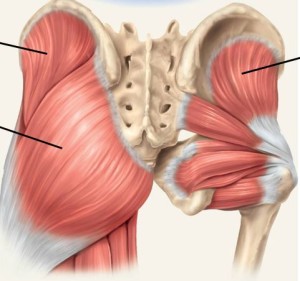
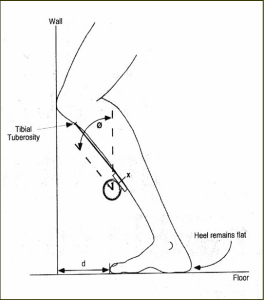
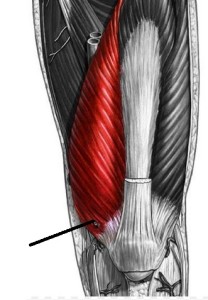

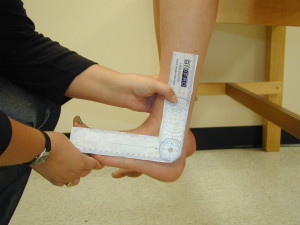
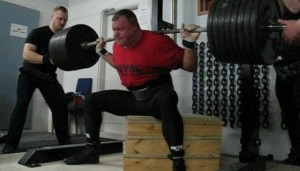
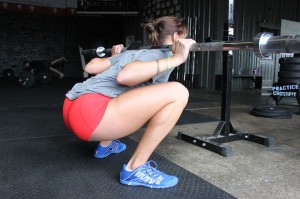
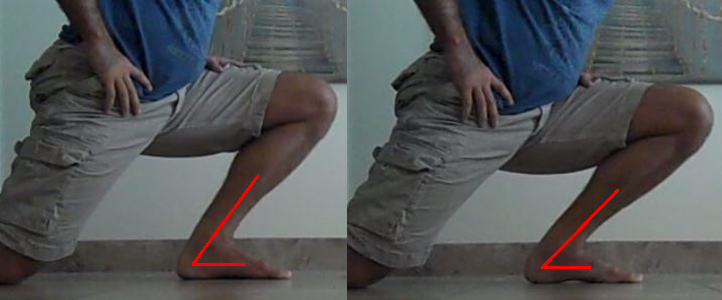

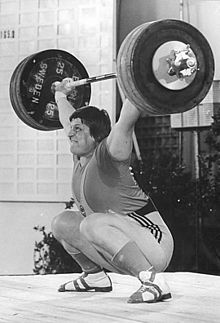
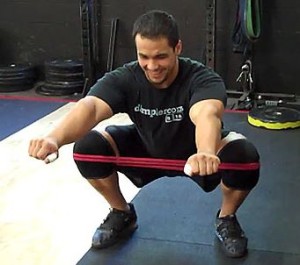
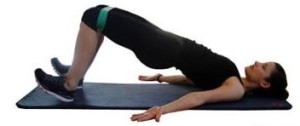
Комментариев нет:
Отправить комментарий